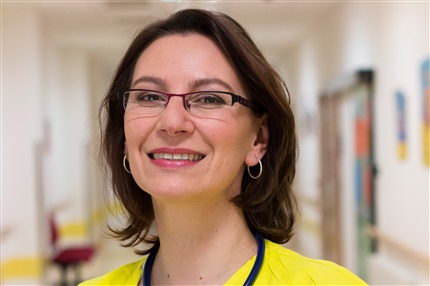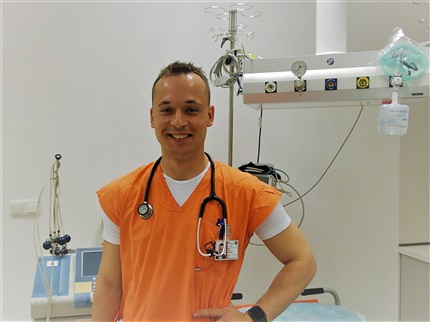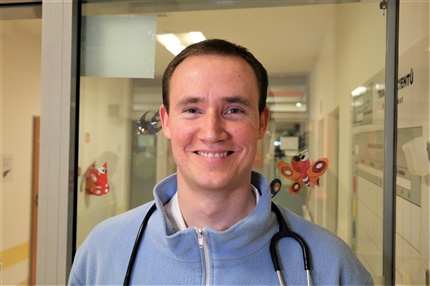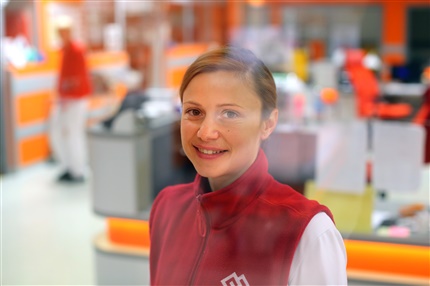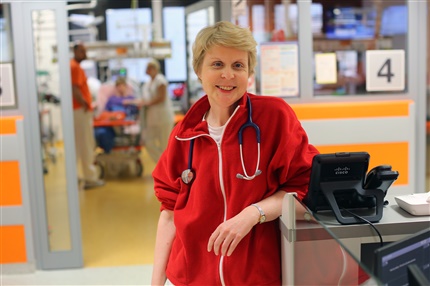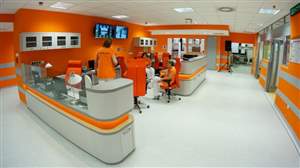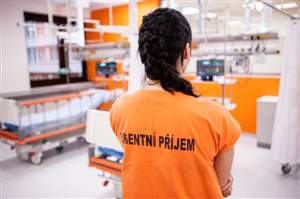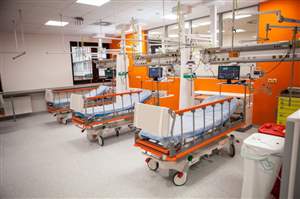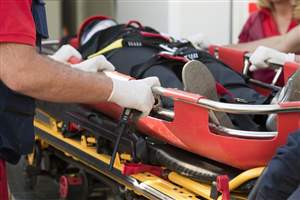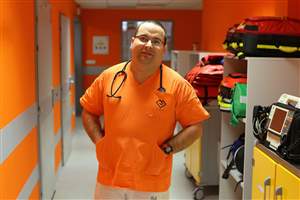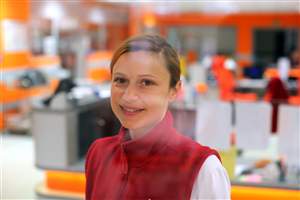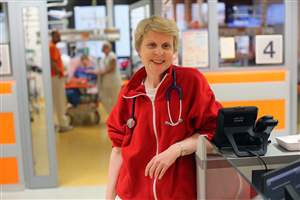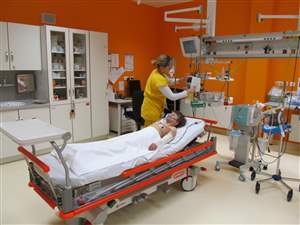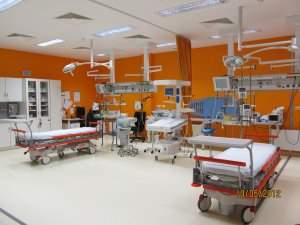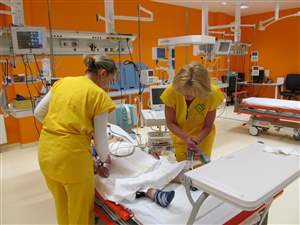A brief overviw of the Emergency Department for Adults and Emergency Department for Children
The Emergency Department for Adults and Emergency Department for Children provide acute emergency care for patients with a sudden health disorder.
Every year about 50.000 adult patients and 33.000 children (from 0 to 18 years of age) arrive at both departments with a number of health conditions that vary in their severity.
The departments cooperate with a majority of the departments and specialized centers in our hospital. Sometimes we call for the resuscitation service from the Specialized Center of Anesthesiology, Resuscitation and Intensive Care Medicine and daily request tens or even hundreds of examinations from the Specialized Center of Radiology and Diagnostic Imaging. We serve as a link between pre-hospital emergency care and hospital ward care.
How will your detailed schedule look like? What type of procedures, methods or treatment can you observe? Check what can you see by shadowing every member of the mentoring team.
Is this specialty placement ideal for you?
- Emergency medicine offers you one huge benefit that other medical specialties cannot - you will see a wide range of patients and conditions that are not specific to one organ or system in the body. You observe various cases every shift and explore the fullness of medicine. Another skill you can learn in the ER is how to be detailed oriented with a capacity to a quick evaluation of facts and decision making. This placement requires you to be very stress resistant and patient at the same time, as most of the patients are transferred to our department in critical conditions and the tempo of our work varies.
- The ER specialty placement is a perfect choice for those of you who want to become a paramedic or a doctor in urgent medicine, who stands in the first line and has the first contact with the patients. As we combine the ER in Children and in Adults, you have a chance to compare both of the different approaches as well as various health conditions.
Let's take a closer look at the specialties…
Patients come to our departments either through the Medical Rescue Service, with their parents or by themselves. As we are alerted to the most severe cases in advance it allows us to prepare properly for any unexpected complications. The biggest benefit of these departments is their systemic purpose. In the past, patients had to go around the hospital searching for doctors. Now, when they come to our departments we take care of everything for them.
If the patients arrive on their own, first they have to visit the reception, where a qualified nurse determines where the patient should be referred – emergency department, traumatology or to the specialized outpatient departments. In more difficult cases, the nurse takes advice from a doctor. The reception runs 24 hours a day and it also serves as a contact place for relatives of the patient. Here, patients can get information about their loved ones and it also acts as a contact place for the medical rescue service.
In case of the Emergency Department for Children, we are the only department of its kind for the whole country and the way how we are organized is a lot similar to the United States, Great Britain or France. We serve as an entrance gate for children with acute health conditions in the whole University hospital in Motol that can be caused by trauma or internal causes. We cooperate closely with the acute pediatric outpatient wards. As our colleagues in the hospital have a unique focus on pediatric specialties, we cooperate with top specialists in the fields of Pediatric Surgery, Orthopedics, Neurology, Neurosurgery, Cardiology or Psychiatry as well as with Radiology and Diagnostic Imaging and Anesthesia.
We have at our disposal high-tech equipment for life-threatening cases which comprise around 5% of all patients. In addition to an operating room at ER for Adults, where we can manage even the most severe conditions, we also have a patients’ wards with 27 beds that are equipped just as in ARU. At ER for Children, we have 3 examination beds, 4 beds for observing, 1 box for patient's isolation, 1 detoxication room and 1 OR for smaller procedures. The layout of our departments is like a small hospital within the large University Hospital in Motol.
In emergency situations, the department acts as an organizational center where the reception becomes a communication center for the dispatching of emergency and rescue services and, in addition, has an overview of the beds in intensive care. On-call doctors are also provided by our department.
Who do we take care of?
The ER doesn't cater for patients suffering from trauma caused by accidents. Instead, these patients are referred to the Traumatology Department. The aim of the Emergency Department is to treat patients whose worsening health conditions have suddenly become acute such as a victim of a stroke or a heart attack. Patients brought to the hospital by ambulance and whose condition requires immediate treatment are always given priority.
In other situations, patients are treated according to the severity of their condition. In the department, our doctors carry out a diagnosis, provide a treatment or suggest further examinations by calling upon a number of interdisciplinary services. They will also decide if a patient needs to be hospitalized and where. Our department takes care of every single patient that requests our help 24/7.
In children, we deal with the acute cases of internal diseases and trauma (around 6.000 children per year). The trauma cases reach the level of 30%, 25% of our patients are hospitalized in the University Hospital in Motol and 75% of our patients are after the evaluation, diagnostics and acute care provided, released from the hospital accompanied by their parents or relatives.
Our methods and procedures
Emergency medicine is a very specific area of healthcare where the number one goal is to treat a patient's condition quickly, appropriately and in line with its requirements. By employing a triage method we can assign treatment to a patient according to the urgency of their condition.
Where there is a need to make a quick, crucial decision about a patient's condition we have at our disposal a number of diagnostic procedures such as Ultrasonography, X rays, Computed Tomography( CT) and Magnetic Resonance Imaging (MRI). In combination with an evaluation of the vital functions by clinical examination and fast laboratory testing, these imaging methods form part of the basic diagnostic procedures in emergency medicine. Furthermore, an inseparable part of our approach is the constant training of doctors and paramedics in the treatment of emergency cases.
The basis of our treatment procedures follows the recommended guidelines for severe injuries such as severe trauma, cerebral stroke, acute coronary syndrome (ACS), gastrointestinal tract bleeding and many more. We cooperate closely with our colleagues in other hospital departments and centers, such as the Specialized Center of Cardiology in cases of ACS, acute myocardial infarction which are treated with percutaneous coronary interventions, Neurology in cases of cerebral strokes treated with thrombolysis, and with surgeons in Traumatology and with the Specialized Center of Neurosurgery and the Specialized Center of Internal Medicine.
How does the usual schedule look like?
- Both of the ER departments run 24/7 and therefore you might have to work a number of shifts: morning, afternoon, night or even at the weekend. The different shifts will also give you an insight into how emergency medicine can vary throughout the week. Your schedule will change according to your mentors’ schedule. It may also mean that you will be asked to take a long shift with the doctor but, in such cases, you will have the next day off. Bear it in mind that you will spend at least 25 hours in the hospital per week. But the actual number of hours may be higher.
If you are not sure whether this choice is suitable for you, don't hesitate to contact us. We will discuss your experience and motivation and come up with the best solution for you.



